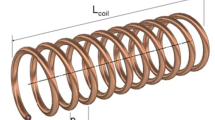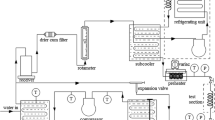Abstract
Capillary tubes with straight, spiral, and helically coiled shapes have been widely used as expansion devices in small refrigeration systems. Many physical models are required to evaluate the refrigerant flow rate through a helically coiled capillary tube because of the complicated flow behavior in such tube. In this study, a numerical model was developed to evaluate refrigerant flow through a helically coiled capillary tube. The mass flow rates predicted using various combinations of empirical correlations were compared with the experimental data available in the open literature, including R22, R134a, R407C, R410A and LPG. On the basis of these comparisons, a recommended set of correlations was selected to calculate the mass flow rates through a helically coiled capillary tube. The present numerical model exhibited good agreement with the experimental data.
Similar content being viewed by others
References
B. G. Kim, D. Kim, D. Lee and Y. Kim, Performance of a two-phase injection heat pump with the variation of injection quality and pressure, International Journal of Air-Conditioning and Refrigeration, 25 (2017) 1750018.
P. Doiphode, M. Kumar and I. Samanta, Simulation-based performance analysis of split air conditioner incorporating copper tubes of smaller diameter, International Journal of Air-Conditioning and Refrigeration, 25 (2017) 1750026.
E. Aridhi, A. Albouchi and A. Mami, Observability and controllability study of a household refrigerator exposed to an outdoor cold airflow using bond graph approach, International Journal of Air-Conditioning and Refrigeration, 25 (2017) 1750001.
J. Gill and J. Singh, Experimental analysis of R134a/LPG as replacement of R134a in a vapor-compression refrigeration system, International Journal of Air Conditioning and Refrigeration, 25 (2017) 1750015.
D. Senthilkumar, Influence of silicon carbide nanopowder in R134a refrigerant used in vapor compression refrigeration system, International Journal of Air-Conditioning and Refrigeration, 25 (2017) 1750007.
M. K. Khan, R. Kumar and P. K. Sahoo, A homogeneous flow model for adiabatic helical capillary tube, ASHRAE Transactions, 114 (2008) 239–249.
S. Chingulpitak and S. Wongwises, Two-phase flow model of refrigerants flowing through helically coiled capillary tubes, Applied Thermal Engineering, 30 (2010) 1927–1936.
G. Zhou and Y. Zhang, Numerical and experimental investigations on the performance of coiled adiabatic capillary tubes, Applied Thermal Engineering, 26 (2006) 1106–1114.
S. Chingulpitak, J. Kaew-on and S. Wongwises, Numerical and experimental investigation of the flow characteristics of R134a flowing through adiabatic helical capillary tubes, International Journal of Air-Conditioning and Refrigeration, 20 (2012) 1250019.
Y. Mori and W. Nakayama, Study on forced convective heat transfer in curved pipes, International Journal of Heat Mass Transfer, 10 (1967) 37–59.
S. W. Churchill, Friction-factor equation spans all fluid-flow regimes, Chemical Engineering, 84 (1977) 91–92.
C. M. White, Streamline flow through curved pipes, Proceedings of the Royal Society of London Series A, 123 (1929) 645–663.
E. F. Schmidt, Warmeubergang und druckverlust in rohrschlangen, The chemical Engineering and Technology, 39 (1967) 781–789.
L.-S. Kim, K.-D. Son, D. Sarker, J. H. Jeong and S. H. Lee, An assessment of models for predicting refrigerant characteristics in adiabatic and non-adiabatic capillary tubes, Heat Mass Transfer, 47 (2011) 163–180.
D. Sarker, L.-S. Kim, K.-D. Son, J. H. Jeong and K. S. Chang, An evaluation of constituent correlations for predicting refrigerant characteristics in adiabatic capillary tubes, International Journal of Air-Conditioning and Refrigeration, 18 (2010) 131–139.
H. Ju, Z. Huang, Y. Xu, B. Duan and Y. Yu, Hydraulic performance of small bending radius helical coil-pipe, Journal of Nuclear Science and Technology, 38 (2001) 826–831.
W. R. Dean and J. M. Hurst, Note on the motion of fluid in a curved pipe, Mathematika, 6 (1959) 77–85.
Z. L. Miropolskiy, Heat transfer in film boiling of a steam-water mixture in steam-generator tubes, Teploenergetika, 10 (1963) 49–52.
W. H. McAdams, W. K. Woods and L. C. Heroman, Vaporization inside horizontal tubes II-benzene-oil mixtures, Transactions of ASME, 64 (1942) 193–200.
A. Cicchitti, C. Lombardi, M. Silvestri, G. Soldaini and R. Zavattarelli, Two-phase Cooling Experiments: Pressure Drop, Heat Transfer and Burnout Measurements (No. CISE-71), Milan: Centro Informazioni Studi Esperienze (1959).
A. E. Dulker, M. Wicks and R. G. Cleveland, Pressure drop and hold up in two-phase flow. Part A. A comparison of existing correlations. Part B. An approach through similarity analysis, ALChE J., 10 (1964) 38–51.
S. Lin, P. A. Kew and K. Cornwell, Two-phase heat transfer to a refrigerant in a 1 mm diameter tube, International Journal of Refrigeration, 24 (2001) 51–56.
S. C. R. Dennis, Calculation of the steady flow through a curved tube using a new finite-difference method, Journal of Fluid Mechanics, 99 (1980) 449–467.
H. Ito, Laminar flow in curved pipes, ZAMM-Journal of Applied Mathematics and Mechanics, 11 (1969) 653–663.
S. Yanase, N. Goto and K. Yamamoto, Dual solutions of the flow through a curved tube, Fluid Dynamics Research, 5 (1989) 191–201.
J. H. Yun and J. H. Jeong, A review of prediction methods for two-phase pressure loss in mini/micro-channels, International Journal of Air-Conditioning and Refrigeration, 24 (2016) 1630002.
L. Friedel, Improved friction pressure drop correlation for horizontal and vertical two-phase pipe flow, European Two-Phase Flow Group Meeting (1979) Paper E2, Ispra.
H. Muller-steinhagen and K. Heck, A simple friction pressure drop correlation for two-phase flow in pipes, Chemical Engineering and Processing: Process Intensification, 20 (1986) 297–308.
Z. H. Chen, R. Y. Li, S. Lin and A. Y. Chen, A correlation for metastable flow of R-12 through capillary tubes, ASHRAE Transactions, 96 (1990) 550–554.
C. Lackme, Incompleteness of the flashing of a supersaturated liquid and sonic ejection of the produced phases, International Journal of Multiphase Flow, 5 (1979) 131–141.
F. A. S. Fiorelli, C. A. S. Silva and A. A. S. Huerta, Me-tastable flow of R-410A in capillary tubes, Applied Thermal Engineering, 51 (2013) 1181–1190.
E. Dirik, C. Inan and M. Y. Tanes, Numerical and experimental studies on adiabatic and nonadiabatic capillary tubes with HFC-134a, International Refrigeration and Air Conditioning Conference at Purdue University, West Lafayette, Indiana, USA (1994).
R. R. Bittle and M. B. Pate, A theoretical model for predicting adiabatic capillary tube performance with alternative refrigerants, ASHRAE Transactions, 102 (1996) 52–64.
V. Feburie, M. Giot, S. Granger and J. M. Seynhaeve, A model for choked flow through cracks with inlet subcooling, International Journal of Multiphase Flow, 19 (1993) 541–562.
G. Zhou and Y. Zhang, Experimental investigation on hysteresis effect of refrigerant flowing through a coiled adiabatic capillary tube, Energy Conversion and Management, 47 (2006) 3084–3093.
O. Garcia-Valladares, Numerical simulation and experimental validation of coiled adiabatic capillary tubes, Applied Thermal Engineering, 27 (2007) 1062–1071.
P. Javidmand and M. Zareh, An experimental comparison of the refrigerant flow through adiabatic and non-adiabatic helical capillary tubes, International Refrigeration and Air Conditioning Conference, Purdue University, West Lafayette, Indiana, USA (2014).
M. K. Khan, R. Kumar and P. K. Sahoo, Experimental study of the flow of R-134a through an adiabatic helically coiled capillary tube, HVAC & Research, 14 (2008) 749–762.
M. K. Khan, R. Kumar and P. K. Sahoo, An experimental study of the flow of R-134a inside an adiabatic spirally coiled capillary tube, International Journal of Refrigeration, 31 (2008) 970–978.
S. G. Kim, M. S. Kim and S. T. Ro, Experimental investigation of the performance of R22, R407C and R410A in several capillary tubes for air-conditioners, International Journal of Refrigeration, 25 (2002) 521–531.
M. K. Mittal, R. Kumar and A. Gupta, An experimental study of the flow of R-407C in an adiabatic helical capillary tube, International Journal of Refrigeration, 33 (2010) 840–847.
C. Park, S. Lee, H. Kang and Y. Kim, Experimentation and modeling of refrigerant flow through coiled capillary tubes, International Journal of Refrigeration, 30 (2007) 1168–1175.
S. S. Punia and J. Singh, An experimental study of the flow of LPG as refrigerant inside an adiabatic helical coiled capillary tube in vapour compression refrigeration system, Heat Mass Transfer, 51 (2015) 1571–1577.
G. Zhou and Y. Zhang, Inlet pressure fluctuation characteristics of coiled adiabatic capillary tubes, Applied Thermal Engineering, 33 (2012) 183–189.
J. Wang, F. Cao, Z. Wang, Y. Zhao and L. Li, Numerical simulatio of coiled adiabatic capillary tubes in CO2 transcritical systems with separated flow model including metastable flow, International Journal of Refrigeration, 35 (2012) 2188–2198.
M. Zareh, H. Shokouhmand, M. R. Salimpour and M. Taeibi, Numerical simulation and experimental analysis of refrigerants flow through adiabatic helical capillary tube, International Journal of Refrigeration, 38 (2014) 299–309.
Y. A. Cengel and J. M. Cimbala, Fluid Mechanics Fundamentals and Applications, McGraw Hill publication (2006).
Author information
Authors and Affiliations
Corresponding author
Additional information
Recommended by Associate Editor Hyoung-gwon Choi
Won-jong Lee obtained his Ph.D. in the School of Mechanical Engineering, Pusan National University, South Korea, in 2018. He is currently working as a postdoctoral researcher in the same university. His research interest includes heat exchangers and refrigeration systems.
Ji Hwan Jeong is a Professor in the School of Mechanical Engineering, Pusan National University, Busan, South Korea. He obtained his B.S. in Nuclear Engineering from Seoul National University in 1988 and his M.S. and Ph.D. in Nuclear Engineering from KAIST in 1990 and 1995, respectively. His research interests include heat transfer augmentation, heat exchangers, heat pumps, and nuclear thermal hydraulics.
Rights and permissions
About this article
Cite this article
Lee, WJ., Jeong, J.H. Evaluation of the constituent correlations for predicting the refrigerant flow characteristics in adiabatic helically coiled capillary tubes. J Mech Sci Technol 33, 2123–2136 (2019). https://doi.org/10.1007/s12206-019-0415-x
Received:
Revised:
Accepted:
Published:
Issue Date:
DOI: https://doi.org/10.1007/s12206-019-0415-x




